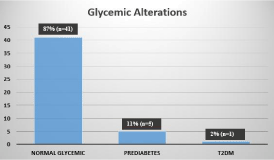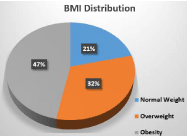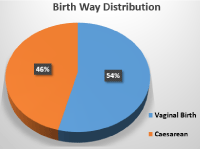Abstract
Background: Macrosomia is defined etymologically as the development of the body to an exaggerated size; in newborns it is defined as a birth weight greater than 4000 grams regardless of gestational age. Some authors such as the American College of Obstetricians and Gynecologists define macrosomia with a weight above 4,500grs. Macrosomia in Mexico represents around 5.4% of births. The risk factors are: antecedent of neonate with macrosomia, maternal weight gain, multiparity, overweight or obese parents, male sex and gestational diabetes mellitus.
Aim: The purpose of this study is to determinate glycemic alterations in women with macrosomic newborn in Tijuana, Mexico.
Design and Setting: Descriptive cross-sectional study.
Methods: In 47 patients in the Family Medicine Unit #27, Tijuana, Mexico; a descriptive cross-sectional study was conducted in women with macrosomic newborn in order to determinate glycemic alterations from March to July 2018. We obtained general data such as age, glycemic alterations, marital status, schooling, weight before pregnancy, weight gained in pregnancy, number of pregnancy, birth way and gestational age. For statistical analysis, we applied descriptive statistics; for qualitative variables frequencies and percentages were used and for quantitative variables mean and standard deviation were used.
Results: 47 patients had a macrosomic neonate; fasting plasma glucose was measured between week 6-12 after birth, where the following results were obtained: 87% (n=41) were found with normal fasting plasma glucose (=70mg/dl to <100mg/dl), 11% (n=5) of patients with glucose between 100-125 mg/dl that results in prediabetes; and 2% (n=1) with glucose =126mg/dl, which translates into diagnosis of type 2 diabetes mellitus.
Conclusion: In recent years the number of patients with diabetes mellitus has increased, finding that the associated factors are strongly related to lifestyles. A high percentage of patients have an obstetric history such as macrosomia or impaired glucose in pregnancy. It is important the follow-up that the patients with macrosomic newborns will have, since in addition to the overweight and obesity, they have a high risk of developing a chronic disease.
Keywords: Macrosomia; Newborn; Glycemic Alterations
Introduction
Human growth results from a complex and interactive process of physiological factors, which takes place in a wide space of genetic traits and environmental influences. The word macrosomia came from the Greek terms makrós and soma, meaning "great" and "body", which is understood by "the development of the body to exaggerated size" [1]. In newborns, macrosomia it is defined as a birth weight greater than 4000 grams regardless of gestational age. Some authors such as the American College of Obstetricians and Gynecologists define macrosomia with a weight above 4,500grs [2]. The risk factors for macrosomia are characterized by their diversity: gestational diabetes mellitus and diabetes mellitus type 2, advanced age, obesity, gestational gain of weight greater than 15kg, multiparity, prolonged pregnancy and male fetus. Genetic, environmental, constitutional and metabolic risk factors are recognized as independent risk factors for fetal macrosomia [3]. Another additional risk factors are hypothyroidism and hypertension. Metabolic alterations such as gestational diabetes mellitus are the most influential in macrosomia [4].
Macrosomia is a clinically significant risk factor for obstetric complications and metabolic disorders in adult life, such as metabolic syndrome, type 2 diabetes and obesity. Fetal macrosomia is associated with maternal and fetal morbidity and mortality, hypertrophic cardiomyopathy, vascular thrombosis, neonatal hypoglycaemia, cephalopelvic disproportion, traumatisms during childbirth, postpartum haemorrhage, shoulder dystocia and a predisposing factor of obesity in childhood and adolescence [5]. Pregnant women at risk of having a child with macrosomia may need additional support throughout the prenatal and postnatal period. The support must be adapted to the information needs of the patient, with the time allotted to explore the previous experiences of the birth, the beliefs about the macrosomy and the options for the childbirth [6].
The prevention of fetal macrosomia is totally dependent on the correct identification of people at risk. Maternal weight, gestational weight and glycemic control are the risk factors for fetal macrosomia that are more susceptible to intervention and have potential benefits for maternal health beyond pregnancy and childbirth [7]. The options of an accurate diagnostic prediction should be based on 3 steps: a) identification of risk factors, obstetric history, parity, maternal weight and gestational age; b) the measurement of the uterine fundus and; c) ultrasound [8]. There is a need to identify macrosomia in order to prevent perinatal complications; the usefulness of fasting plasma glucose measurement in non-diabetic pregnant women could be useful to make a timely diagnosis [9]. Based on the above, the main objective of the study is to determinate glycemic alterations in women with macrosomic newborn in Tijuana, Mexico.
Materials and Methods
A descriptive cross-sectional study was carried out, in the Family Medicine Unite #27, of the Instituto Mexicano del Seguro Social (IMSS), located in Tijuana, Mexico; in patients which were selected by a consecutive sampling techniques; that met the following inclusion criteria: any age, women with macrosomic newborns (=4,000grs) with measurement of fasting plasma glucose during week 6-12 after birth, it was not necessary to sign the informed consent due to the fact that only clinical records were reviewed; patients with incomplete information were eliminated. The following data were obtained directly from medical records: age, glycemic alterations, marital status, schooling, weight before pregnancy, weight gained in pregnancy, body mass index (BMI), number of pregnancy, birth way and gestational age. The procedure for the data collection was as follows: age was calculated in years according to the year of birth; weight was calculated on a scale with stadiometer (Transcell technology model TI-540-SL); BMI was calculated based on the Quetelet index (BMI = weight/height2); glycemic alterations was determinated with fasting plasma glucose measurement; marital status, schooling, number of pregnancy, birth way and gestational age was obtained directly from medical records. The recollected data was integrated into data collection sheets and analyzed using the SPSS program version 20 in Spanish, where we applied descriptive statistics; for qualitative variables, frequencies and percentages were used and for quantitative variables, mean and standard deviation were used. The Kolmogorov-Smirnoff test was used to establish the normality of the data. The Protocol was authorized by the Local Committee of Research and Ethics in Health Research.
Results
We reviewed the electronic medical record of each women who had a macrosomic newborn in the period between March to July 2018, obtaining a total of 98 patients; of all patients, 52% (n=51) had no fasting plasma glucose measurement after birth or during the sixth and twelfth week, resulting in a total of 47 patients who met the inclusion criteria. Of the 47 patients who had a macrosomic newborn, fasting plasma glucose was measured between week 6-12 after birth, where the following results were obtained (Graphic 1): 87% (n=41) were found with normal fasting plasma glucose (=70mg/dl to <100mg/dl), 11% (n=5) of patients with glucose between 100-125 mg/ dl that results in prediabetes; and 2% (n=1) with glucose =126mg/dl, which translates into a diagnosis of type 2 diabetes mellitus.

Figure 1: Descriptive analysis of the distribution by glycemic alterations.

Figure 2: Descriptive analysis of the distribution by BMI.

Figure 3: Descriptive analysis of the distribution by birth way.
The average age among the participants was 26±5 years; of the 6 patients who presented glycemic alteration, 100% were older than 30 years; the majority of women (48%, n=23) were in free union as the most frequent marital status; the most frequent schooling was secondary (53%, n=25); within the number of pregnancies, 12 (25%) had one pregnancy, 16 (34%) two pregnancies and 19 (40%) three or more pregnancies. In the weight before pregnancy, of the total of women with macrosomic newborns, 10 (21%) are in normal weight, 15 (33%) are overweight and 22 (46%) with obesity (Graphic 2). The way of birth (Graphic 3) more frequent was vaginal birth with 54% (n=25) and cesarean with 46% (n=22).
Discussion and Conclusion
In recent years the number of patients with diabetes mellitus has increased, finding that the associated factors are strongly related to lifestyles. A high percentage of patients have an obstetric history such as macrosomia or impaired glucose in pregnancy. It is important the follow-up that the patients with macrosomic newborns will have, since in addition to the overweight and obesity, they have a high risk of developing a chronic disease. Among the most important characteristics of our population it was found that the majority of women with macrosomic newborns live in a free union, have low educational level and have had three or more pregnancies; the most outstanding is the alterations in weight found among the participants, since only 10 patients had a normal BMI, compared to 37 patients with overweight and obesity, which implies risk factors for the development of chronic diseases such as high blood pressure and type 2 diabetes mellitus. Another of the highlights is the birth way, due to the newborn weight a higher rate of cesareans could be expected, however, in our study a higher rate of vaginal births was found.
References
- Toirac-Lamarque AS, Pascual-López V, Martínez-Jiménez A, Area-suarez RI. Macrosomía fetal en madres no diabéticas. Caracterización mínima. MEDISAN. 2013; 17: 1-13.
- Legardeur H, Girard G, Journy N, Ressencourt V, Durand-Zaleski I, Mandelbrot L. Factors predictive of macrosomia in pregnancies with a positive oral glucose challenge test: Importance of fasting plasma glucose. Diabetes&Metabolism. 2014; 40: 43-48.
- Liu F, Zhao C, Liu L, Ding H, Huo R, Shi Z. Peptidome profiling of umbilical cord plasma associated gestational diabetes-induced fetal macrosomia. Journal of Proteomics. 2016; 139: 38-44.
- Vendittelli F, Rivière O, Brèart G. Is prenatal identification of fetal macrosomia useful?. European Journal of Obstetrics & Gynecology and Reproductive Biology. 2012; 161: 170-176.
- Araujo-Junior E, Borges-Peixoto A, Perez-Zamarian A, Elito Júnior J, Tonni G. Macrosomia. Best Practice & Research Clinical Obstetrics and Gynaecology. 2017; 38: 82-96.
- García-De la Torre J, Rodríguez-Valdez A, Delgado-Rosas A. Factores de riesgo de macrosomía fetal en pacientes sin diabetes mellitus gestacional. Ginecol Obstet Mex. 2016; 84: 164-171.
- Ogonowski J, Miazgowski T. Intergenerational transmission of macrosomia in women with gestational diabetes and normal glucose tolerance. European Journal of Obstetrics & Gynecology and Reproductive Biology. 2015; 195: 113-116.
- Aranha A, Malabu U, Vangaveti V, Reda ES, Tan YM, Sangla KS. Macrosomia in non-gestational diabetes pregnancy: glucose tolerance test characteristics and feto-maternal complications in tropical Asia Pacific Australia. Asian Pac J Trop Biomed. 2014; 4: 436-440.
- Maiz N, Plasencia W. Cribado precoz de diabetes gestacional y macrosomia. Prog Obstret Ginecol. 2014; 57: 472-480.
